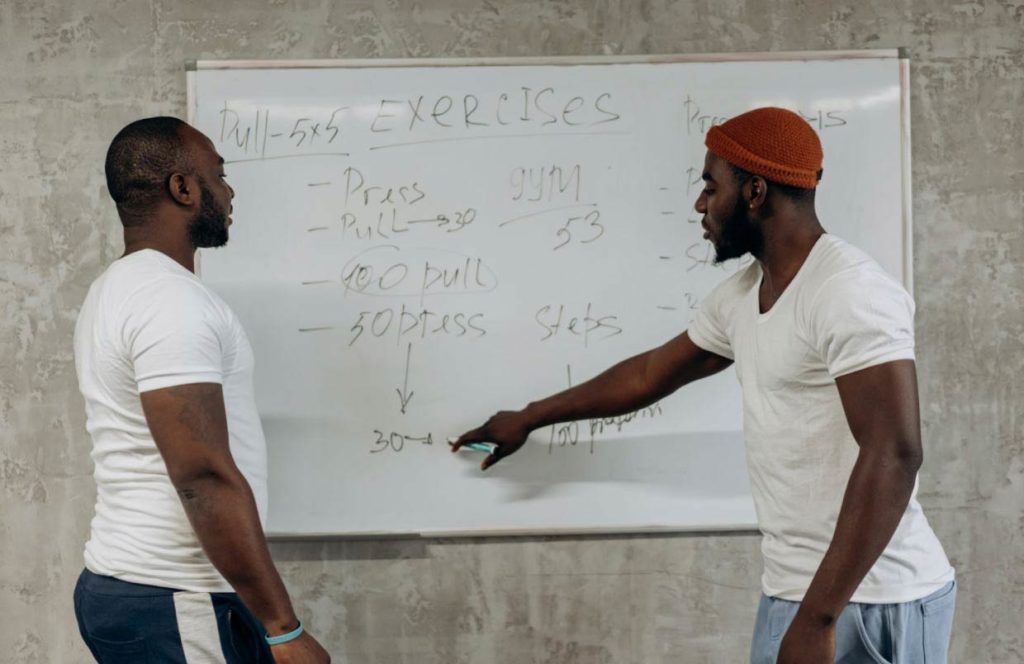One of the most frequent questions we get regarding training is how often you should change your workout routine.
There’s no one specific answer that’s right for everyone, which is why working with a trainer can be so valuable to help you get results.
Even though there’s no particular correct answer, we can give you a little guidance so you at least have an idea of how quickly your body might plateau if you don’t switch things up.
If you do the same things day in and day out, you’re going to hit a point where your body is no longer changing. You’re not optimizing your workouts to continue to create a powerful, healthy body, and it’s one of the big workout mistakes to avoid.
When you change your workout plan, you’re avoiding one of the most common workout mistakes. You can make sure you’re regularly increasing your heart rate with more intense workouts. Changing it up in your workout program will help you work out more effectively and encourage muscle growth, burn more calories, muscle gains, and allow you to stay interested in your exercise routine.
What is a Workout Plateau?
The big concern with not changing up your workouts is what’s called a plateau. A plateau can be a problem because once you hit that point, you will not see increasing results, and it can also make you lose your motivation. The last thing you want to do is find yourself at a plateau point and then stop working out altogether because of a stale exercise program.
Ok, so what’s a plateau?
The term refers to a situation where your progress comes to a halt or slows down, even though you’re doing everything right. In this context, everything right means that you’re exercising, eating well, and getting enough rest and recovery time.
Everyone’s plateau can look a little different. For example, you might not be building muscle like you were initially, or your weight could be stuck at a number on the scale.
We want and need to make progress when we put effort into anything, including our workouts.
It’s worth mentioning something here—you can plateau because you’re always doing the same workout, but you can also hit this point if you overtrain. Repetition is what we most commonly associate with plateauing, but if you overtrain, your body doesn’t get enough repair time between your workouts. When your muscles don’t get time to repair and build during a rest period, you won’t see results, or at least not as quickly as you might like.
Repetition and overtraining are the biggest culprits for feeling like you aren’t achieving the results you want in weight training especially, but there are a few other that can happen too:
-
Your workouts aren’t challenging enough. You need to be pushing yourself with your workout intensity for the most health benefits.
-
You’re not keeping up with your nutrition. Sometimes we see people who think they’ve hit a stall in their workouts, despite doing everything right. Then, when they take a closer look at their nutrition, they realize that’s a big issue.
-
Are your goals appropriate for you? If you have unrealistic goals, you’re not going to meet them, and you might think it’s a plateau. The reality is that you’ve created expectations for yourself that aren’t in line with your fitness level.
-
It could be time to work with a trainer. You’ve been powering through your workouts and going hard, but you do not see the benefits. Suppose that sounds like you; think about investing in a trainer. You don’t necessarily have to work with a trainer every time you work out to get benefits.
No matter how good of shape you’re in, you can hit a plateau.
You should track your progress long-term, outside of weight loss to know how you’re doing with fitness. Write down every workout you do. Training for lifting weights includes how many reps you’re doing and how much weight each time, For example, how much weight do you bench press? How many reps do you do?
Take photos of yourself at least once a week, and measure yourself to see if you’re losing inches. Tracking your body fat is another good way to know if you’re plateauing or maybe you just aren’t losing weight. If you’re gaining muscle mass, that might be why you aren’t losing as much weight.
How do you feel when you work out?
How’s your range of motion, for example?
Do you see improvements?

Other Risks Of Not Changing Your Workouts
Now that we’ve talked about plateaus and meeting your goals, we should point out there are a few other reasons you need to make sure you change your workouts up regularly.
First, if you’re constantly doing the same workouts, you might find that you develop muscle imbalances.
For example, if you’re only training your upper body repeatedly without giving the same attention to your lower body, it can cause a risk of injuries.
If you’re a woman, you should think about your hormones and how those can influence your workouts. For example, if you’re on your menstrual cycle, you might want to focus on low-intensity exercises during that time. Then, when you’re not, you can amp it up a bit.
Finally, we touched on this above, but it’s boring if you’re doing the same thing every day. When you’re bored, it’s going to be challenging to stay motivated. Changing up your physical activity isn’t just good for your body—it’s also good for your mind.
How Often to Change Your Workout Routines
So, back to the original question—how often should you change your workout routine?
Here’s the thing with changing it up—you don’t have to go crazy. You can make small changes in your routine and type of training every week, for example. You might aim to get your target heart rate at a higher point, or you could use heavier weights.
This will allow you to keep challenging yourself mentally and physically and have some consistency so you can track your progress. At Fort Fitness, we change up the muscle groups that we work in our classes daily!
Some other ways to change how you exercise include:
-
Your frequency—you can increase or decrease how often you’re working out. If you increase, it’s more challenging, but if you decrease it, there are benefits because you’re giving yourself more recovery time.
-
Intensity—it’s always a good idea to train with varying intensity—for example, alternate periods of longer, steady-state cardio with high-intensity training and cardiovascular exercises. Your body won’t get used to any one routine.
-
Length—how long do you usually work out? If you tend to do longer, lower-intensity workouts, then do shorter interval training options, too, suitable for heart health.
-
Type—maybe you only do cardio right now, so add in some strength training to see significant changes in your body, and vice versa. Cross-training can bring physical benefits. If you usually run, then try adding in yoga.
Most beneficial for our overall wellness is progressive overload. We get stronger when we consistently challenge ourselves. There’s a survival element to a plateau. Your body is adapting to something stressful and difficult.
You’re adding muscle, strength, or endurance in response to what you put it through during your workout. However, the same activities stop being stressful; therefore, our body isn’t motivated to change.
Progressive overload encourages you to change things up, but there has to be a balance. If you’re changing your workouts too often, then you’re also not going to be able to meet your fitness goal.
Fitness professionals know when to switch things up and how to best do it without sacrificing your goals. A great personal trainer will eliminate poor form and teach proper form. Your trainer can make sure that you’re achieving personal goals whether you’re doing a cardio workout, full-body workouts, compound exercises, or you’re using gym equipment.
It’s not just about routinely switching up your workout to see results. It’s about making meaningful changes, which is where we come into the equation.
Ready for a meaningful change in your life? Sign up for Fort Fitness today by calling 949-544-1557, and change into the best version of yourself.





